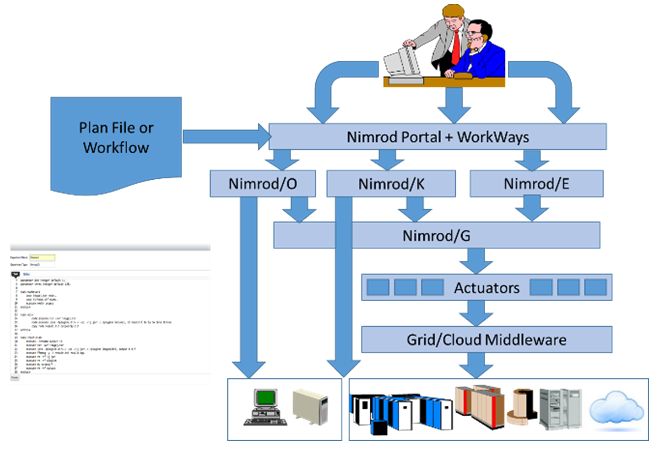Nimrod
Nimrod is a specialised parametric modelling system that helps researchers run simulations and experiments using cloud and hig- performance computing.
Parametric computational experiments are important in science and engineering as a means of exploring the behaviour of complex systems. For example, an engineer may explore the behaviour of a wing by running a computational model of the airfoil multiple times, while varying key parameters such as angle of attack and air speed. The results of these experiments yield a picture of how the wing will behave in different parts of parametric space. The same process can be applied in other experiments that involve parametric modelling.
Nimrod uses a simple declarative parametric modelling language to express a parametric experiment. It provides the machinery to automate the task of formulating, running, monitoring, collating, presenting and visualising the results from multiple individual experiments.
Nimrod consists of a set of tools that include:
Nimrod-G for accessing computational resources of the grid.
Nimrod-K for building your computations, modelling, visualisation and storage into unified scientific workflows.
Nimrod-O for optimising searches across potentially millions of combinations of research parameters.
Nimrod-E for identifying what parameters are relevant to your experiment.
RCC provides training for all the Nimrod tools. To request training, or for any other queries about Nimrod or Embedded Nimrod, please email the RCC Service Desk: rcc-support@uq.edu.au

Embedded Nimrod is a version of Nimrod that runs your entire experiment as a single job within the HPC workload manager. Experiments running as multiple jobs can experience delays as the workload manager schedules and allocates resources for each new job. Embedded Nimrod builds a miniature Nimrod environment in a HPC workload manager job to that can run your experiment plan file from start to finish.
It is best suited to workloads that need to be repeated many times for statistical sampling or differing input parameters, and to tasks with relatively low setup and tear down times and computational footprint.
RCC supports researchers from various disciplines that have use cases for Embedded Nimrod, including inland drayage, traffic simulation, genome analysis, molecular simulations, threatened species, spatial ecology, and brain imaging.
